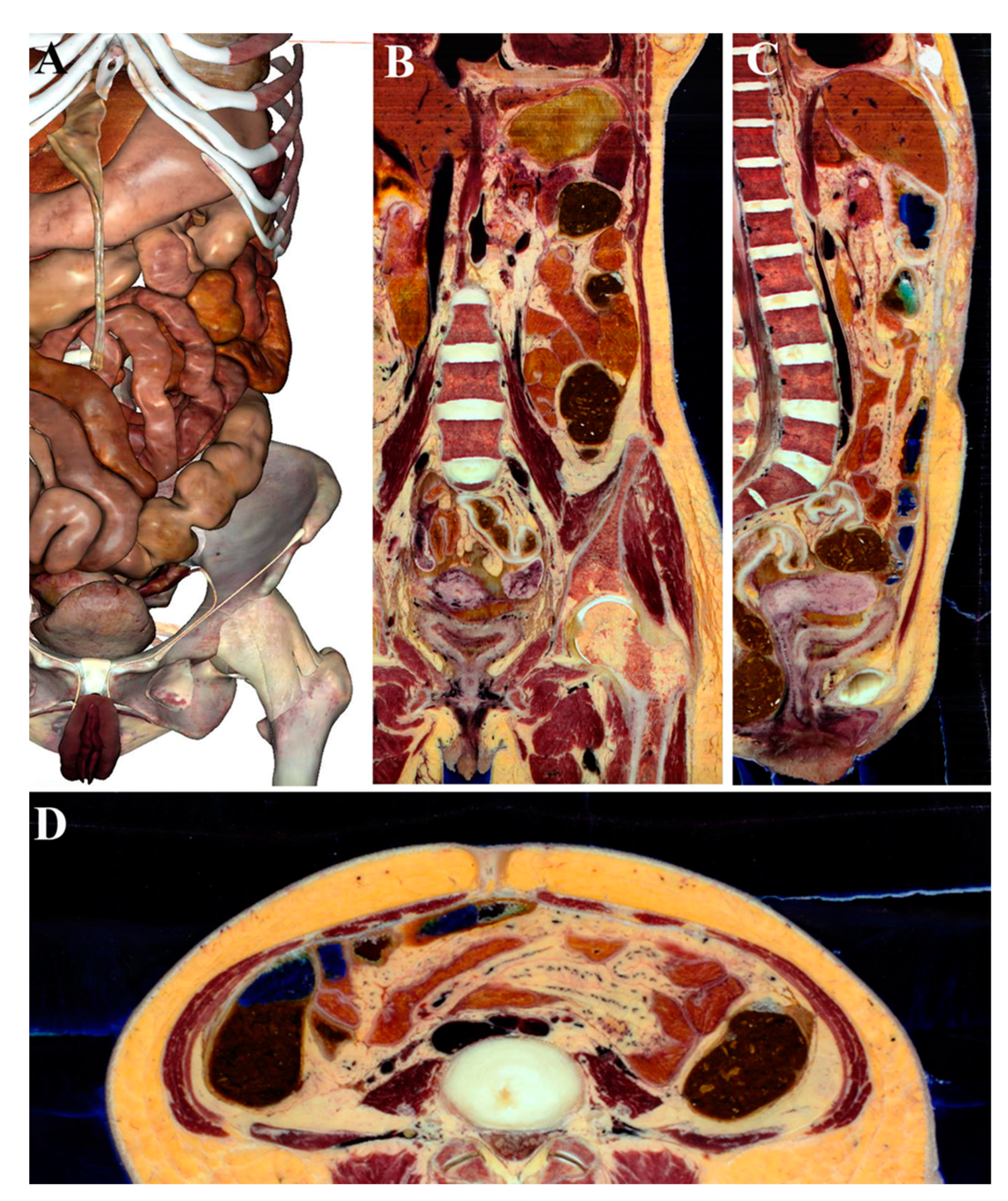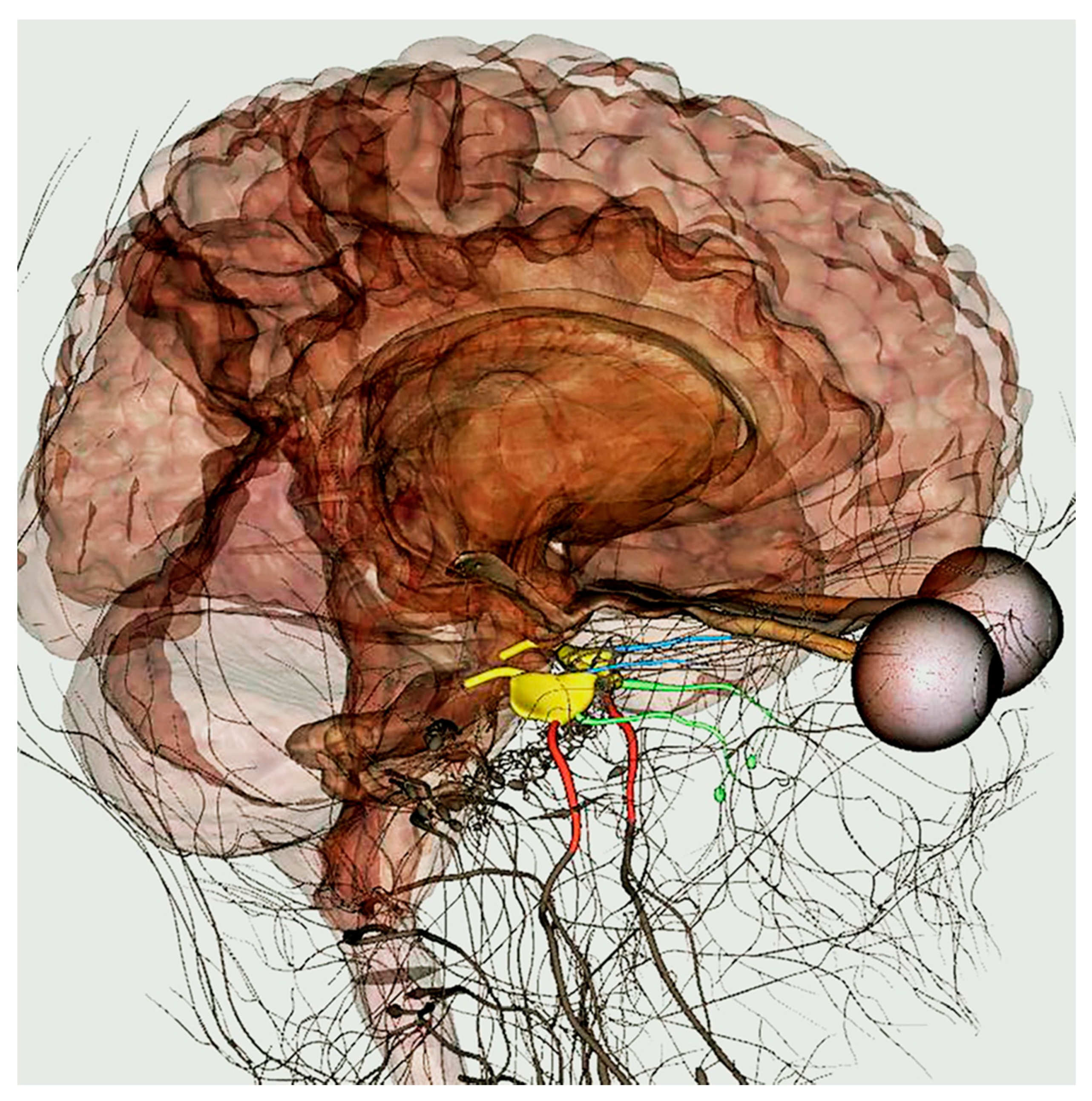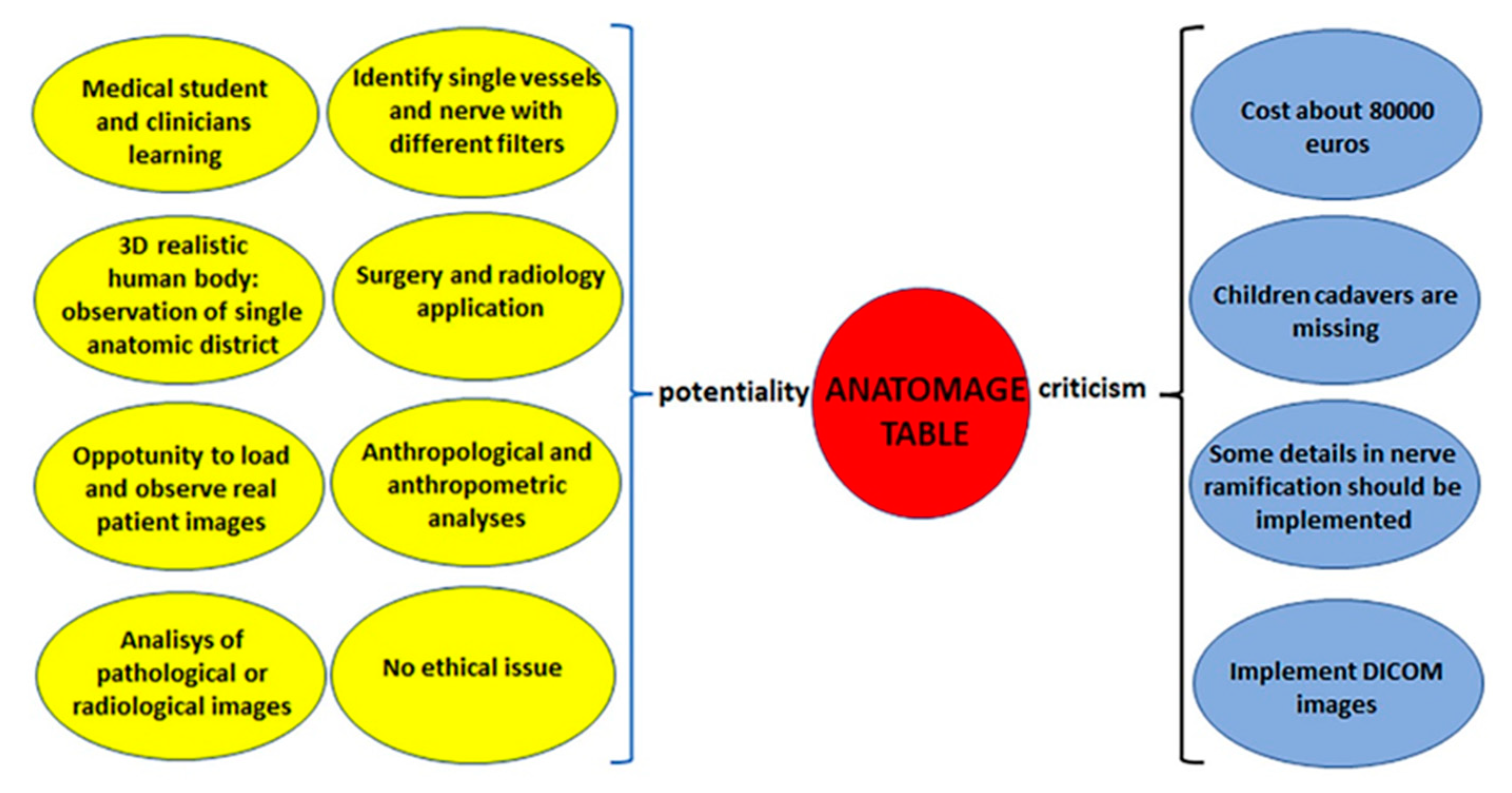Three-Dimensional Virtual Anatomy as a New Approach for Medical Student’s Learning
Abstract
1. Introduction
2. Materials and Methods
3. Results
3.1. Anatomage for Student Learning
3.2. Anatomage in Clinical Practice
3.3. Anatomage Table Utility during the COVID-19 Pandemic
4. Conclusions
Author Contributions
Funding
Institutional Review Board Statement
Informed Consent Statement
Data Availability Statement
Conflicts of Interest
References
- Turney, B.W. Anatomy in a Modern Medical Curriculum. Ann. R. Coll. Surg. Engl. 2007, 89, 104–107. [Google Scholar] [CrossRef] [PubMed]
- Baratz, G.; Wilson-Delfosse, A.L.; Singelyn, B.M.; Allan, K.C.; Rieth, G.E.; Ratnaparkhi, R.; Jenks, B.P.; Carlton, C.; Freeman, B.K.; Wish-Baratz, S. Evaluating the Anatomage Table Compared to Cadaveric Dissection as a Learning Modality for Gross Anatomy. Med. Sci. Educ. 2019, 29, 499–506. [Google Scholar] [CrossRef]
- Kumar, R.; Singh, R. Model pedagogy of human anatomy in medical education. Surg. Radiol. Anat. 2020, 42, 355–365. [Google Scholar] [CrossRef] [PubMed]
- Saverino, D. Teaching anatomy at the time of COVID-19. Clin. Anat. 2021, 34, 1128. [Google Scholar] [CrossRef] [PubMed]
- Thompson, A.R.; Giffin, B.F. Higher-Order Assessment in Gross Anatomy: A Comparison of Performance on Higher- versus Lower-Order Anatomy Questions between Undergraduate and First-Year Medical Students. Anat. Sci. Educ. 2021, 14, 306–316. [Google Scholar] [CrossRef] [PubMed]
- Kraszpulska, B.; Bomkamp, D.; Brueckner-Collins, J. Benefits of Traditional Cadaveric Dissection in a Digital World: Medical and Dental Students’Perspectives. Med. Sci. Educ. 2013, 23, 27–34. [Google Scholar] [CrossRef]
- Parker, E.; Randall, V. Learning beyond the Basics of Cadaveric Dissection: A Qualitative Analysis of Non-academic Learning in Anatomy Education. Med. Sci. Educ. 2020, 31, 1–7. [Google Scholar] [CrossRef]
- Ghosh, S.K. Cadaveric dissection as an educational tool for anatomical sciences in the 21st century. Anat. Sci. Educ. 2017, 10, 286–299. [Google Scholar] [CrossRef]
- Koop, C.F.A.; Marschollek, M.; Schmiedl, A.; Proskynitopoulos, P.J.; Behrends, M. Does an Audiovisual Dissection Manual Improve Medical Students’ Learning in the Gross Anatomy Dissection Course? Anat. Sci. Educ. 2021, 14, 615–628. [Google Scholar] [CrossRef]
- Bakalarski, P.; Klepacka, M.; Sówka, K.; Boyko, I.; Głowala, D.; Bodecot, B.; Pinet Peralta, L.M. Cadaver as a didactic tool for auscultating lung sounds. Crit. Care Innov. 2019, 2, 11–18. [Google Scholar]
- Orsini, E.; Quaranta, M.; Ratti, S.; Mariani, G.A.; Mongiorgi, S.; Billi, A.M.; Manzoli, L. The whole body donation program at the university of Bologna: A report based on the experience of one of the oldest university in Western world. Ann. Anat. 2021, 234, 151660. [Google Scholar] [CrossRef] [PubMed]
- Boscolo-Berto, R.; Tortorella, C.; Porzionato, A.; Stecco, C.; Picardi, E.E.E.; Macchi, V.; De Caro, R. The additional role of virtual to traditional dissection in teaching anatomy: A randomised controlled trial. Surg. Radiol. Anat. 2021, 43, 469–479. [Google Scholar] [CrossRef] [PubMed]
- Estai, M.; Bunt, S. Best teaching practices in anatomy education: A critical review. Ann. Anat. 2016, 208, 151–157. [Google Scholar] [CrossRef]
- Narnaware, Y.; Neumeier, M. Use of a virtual human cadaver to improve knowledge of human anatomy in nursing students: Research article. Teach. Learn. Nurs. 2021, 16, 309–314. [Google Scholar] [CrossRef]
- Cheng, K.H.; Tsai, C.C. Affordances of Augmented Reality in Science Learning: Suggestions for Future Research. J. Sci. Educ. Technol. 2013, 22, 449–462. [Google Scholar] [CrossRef]
- Akçayır, M.; Akçayır, G. Advantages and challenges associated with augmented reality for education: A systematic review of the literature. Educ. Res. Rev. 2017, 20, 1–11. [Google Scholar] [CrossRef]
- Preim, B.; Saalfeld, P. A survey of virtual human anatomy education systems. Comput. Graph. 2018, 71, 132–153. [Google Scholar] [CrossRef]
- Fyfe, S.; Fyfe, G.; Dye, D.; Radley-Crabb, H. The Anatomage table: Differences in student ratings between initial implementation and established use. Focus Health Prof. Educ. Multi-Prof. J. 2018, 19, 41. [Google Scholar] [CrossRef]
- Panagouli, E.; Tsirigoti, A.; Kotsira, G.; Demesticha, T.; Skandalakis, P.; Troupis, T.; Filippou, D. An Unusual Bilateral Duplication of the Suprascapular Vein and Its Relation to the Superior Transverse Scapular Ligament Revealed by Anatomage Table. Acta Med. Acad. 2019, 48, 307–311. [Google Scholar] [CrossRef] [PubMed][Green Version]
- Custer, T.M.; Michael, K. The utilization of the Anatomage virtual dissection table in the education of imaging science students. J. Tomogr. Simul. 2015, 1, 102. [Google Scholar]
- Paech, D.; Giesel, F.L.; Unterhinninghofen, R.; Schlemmer, H.-P.; Kuner, T.; Doll, S. Cadaver-specific CT scans visualized at the dissection table combined with virtual dissection tables improve learning performance in general gross anatomy. Eur. Radiol. 2017, 27, 2153–2160. [Google Scholar] [CrossRef] [PubMed]
- Chew, F.S.; Relyea-Chew, A.; Ochoa, E.R., Jr. Postmortem Computed Tomography of Cadavers Embalmed for Use in Teaching Gross Anatomy. J. Comput. Assist. Tomogr. 2006, 30, 949–954. [Google Scholar] [CrossRef] [PubMed]
- Brucoli, M.; Boccafoschi, F.; Boffano, P.; Broccardo, E.; Benech, A. The Anatomage Table and the placement of titanium mesh for the management of orbital floor fractures. Oral Surg. Oral Med. Oral Pathol. Oral Radiol. 2018, 126, 317–321. [Google Scholar] [CrossRef] [PubMed]
- Eickmeyer, S.; Wertsch, J.; Lewandowski, L.; Hoagland, T.; Braza, D. Teaching pelvic floor musculoskeletal anatomy using Anatomage. Clin. Anat. 2013, 26, 1042. [Google Scholar]
- Brown, J.; Stonelake, S.; Anderson, W.; Abdulla, M.; Toms, C.; Farfus, A.; Wilton, J. Medical student perception of anatomage—A 3D interactive anatomy dissection table. Int. J. Surg. 2015, 23, S17–S18. [Google Scholar] [CrossRef]
- Lewandowski, L.; Wertsch, J.; Hoagland, T.; Braza, D. Exploration of Anatomage interfaced with ECHO 360 software. Clin. Anat. 2013, 26, 1048. [Google Scholar]
- Chung, B.S.; Shin, D.S.; Brown, P.; Choi, J.; Chung, M.S. Virtual Dissection Table Including the Visible Korean Images, Complemented by Free Software of the Same Data. Int. J. Morphol. 2015, 33, 440–445. [Google Scholar] [CrossRef][Green Version]
- Bork, F.; Stratmann, L.; Enssle, S.; Eck, U.; Navab, N.; Waschke, J.; Kugelmann, D. The Benefits of an Augmented Reality Magic Mirror System for Integrated Radiology Teaching in Gross Anatomy. Anat. Sci. Educ. 2019, 12, 585–598. [Google Scholar] [CrossRef] [PubMed]
- DiLullo, C.; McGee, P.; Kriebel, R.M. Demystifying the Millennial student: A reassessment in measures of character and engagement in professional education. Anat. Sci. Educ. 2011, 4, 214–226. [Google Scholar] [CrossRef] [PubMed]
- Ghosh, S.K. Transformation of the role of human dissection in medical education: Cultivating principles of medical ethics. Surg. Radiol. Anat. 2020, 42, 855–856. [Google Scholar] [CrossRef]
- Ward, T.M.; Wertz, C.I.; Mickelsen, W. Anatomage Table Enhances Radiologic Technology Education. Radiol. Technol. 2018, 89, 304–306. [Google Scholar] [PubMed]
- Bhandari, K.; Acharya, S.; Srivastava, A.K.; Kumari, R.; Nimmagada, H.K. Plastination: A new model of teaching anatomy. Int. J. Anat. Res. 2016, 4, 2626–2629. [Google Scholar] [CrossRef]
- Allsop, S.; Hollifield, M.; Huppler, L.; Baumgardt, D.; Ryan, D.; Eker, M.; Spear, M.; Fuller, C. Using videoconferencing to deliver anatomy teaching to medical students on clinical placements. Transl. Res. Anat. 2020, 19, 100059. [Google Scholar] [CrossRef]
- Alfawzan, A.; Alfawzan, O.; Alessa, R.; Alturki, A.; Alshiha, K.; Omair, A.; Agha, S.; Mahzari, M. An assessment of learning styles among undergraduate medical students at King Saud Bin Abdulaziz University (KSAUHS), King Saud University (KSU) and Imam Mohammad Ibn Saud Islamic University (IMSIU). Res. Sq. 2020. [Google Scholar] [CrossRef]
- Bin Abdulrahman, K.A.; Jumaa, M.I.; Hanafy, S.M.; Elkordy, E.A.; Arafa, M.A.; Ahmad, T.; Rasheed, S. Students’ Perceptions and Attitudes After Exposure to Three Different Instructional Strategies in Applied Anatomy. Adv. Med. Educ. Pract. 2021, 12, 607–612. [Google Scholar] [CrossRef] [PubMed]
- Brucoli, M.; Boffano, P.; Pezzana, A.; Sedran, L.; Boccafoschi, F.; Benech, A. The potentialities of the Anatomage Table for head and neck pathology: Medical education and informed consent. Oral Maxillofac. Surg. 2020, 24, 229–234. [Google Scholar] [CrossRef] [PubMed]
- Alraddadi, A. Literature Review of Anatomical Variations: Clinical Significance, Identification Approach, and Teaching Strategies. Cureus 2021, 13, e14451. [Google Scholar] [CrossRef]
- Strantzias, P.; Botou, A.; Manoli, A.; Skandalakis, P.N.; Filippou, D. Variation of Marginal Mandibular Nerve in a Caucasian Male Cadaver: A Study Using the Anatomage Table. Cureus 2019, 11, e6168. [Google Scholar] [CrossRef]
- Standring, S.; Borley, N.R.; Collins, P.; Crossman, A.R.; Gatzoulis, M.A.; Healy, J.C.; Johnson, D.; Mahadevan, V.; Newell, R.I.M.; Wigley, C.B. (Eds.) Gray’s Anatomy. The Anatomical Basis of Clinical Practice, 40th ed.; Elsevier: Edinburgh, UK, 2008. [Google Scholar]
- Al-Redouan, A.; Kachlik, D. Letter to the Editor: Regarding “An Unusual Bilateral Duplication of the Suprascapular Vein and Its Relation to the Superior Transverse Scapular Ligament Revealed by Anatomage Table”. Acta Med. Acad. 2020, 49, 297–298. [Google Scholar] [CrossRef] [PubMed]
- Tirelli, G.; de Groodt, J.; Sia, E.; Belgrano, M.G.; Degrassi, F.; Boscolo-Rizzo, P.; Cova, M.A.; Marcuzzo, A.V. Accuracy of the Anatomage Table in detecting extranodal extension in head and neck cancer: A pilot study. J. Med. Imaging 2021, 8, 014502. [Google Scholar] [CrossRef]
- Kurt Bayrakdar, S.; Orhan, K.; Bayrakdar, I.S.; Bilgir, E.; Ezhov, M.; Gusarev, M.; Shumilov, E. A deep learning approach for dental implant planning in cone-beam computed tomography images. BMC Med. Imaging 2021, 21, 86. [Google Scholar] [CrossRef] [PubMed]
- Abdulqader, A.A.; Ren, L.; Alhammadi, M.; Abdu, Z.A.; Mohamed, A.A.S. Three-dimensional analysis of temporomandibular joint in Chinese adults with normal occlusion and harmonious skeleton. Oral Radiol. 2020, 36, 371–382. [Google Scholar] [CrossRef] [PubMed]
- Zheng, Y.-Y.; Ma, Y.-T.; Zhang, J.-Y.; Xie, X. COVID-19 and the cardiovascular system. Nat. Rev. Cardiol. 2020, 17, 259–260. [Google Scholar] [CrossRef] [PubMed]
- Tajbakhsh, A.; Gheibi Hayat, S.M.; Taghizadeh, H.; Akbari, A.; Inabadi, M.; Savardashtaki, A.; Johnston, T.P.; Sahebkar, A. COVID-19 and cardiac injury: Clinical manifestations, biomarkers, mechanisms, diagnosis, treatment, and follow up. Expert Rev. Anti Infect. Ther. 2021, 19, 345–357. [Google Scholar] [CrossRef] [PubMed]
- Ronco, C.; Reis, T. Kidney involvement in COVID-19 and rationale for extracorporeal therapies. Nat. Rev. Nephrol. 2020, 16, 308–310. [Google Scholar] [CrossRef] [PubMed]
- Ertuğlu, L.A.; Kanbay, A.; Afşar, B.; Elsürer Afşar, R.; Kanbay, M. COVID-19 and acute kidney injury. Tuberk. Toraks 2020, 68, 407–418. [Google Scholar] [CrossRef]
- Zhang, C.; Shi, L.; Wang, F.-S. Liver injury in COVID-19: Management and challenges. Lancet Gastroenterol. Hepatol. 2020, 5, 428–430. [Google Scholar] [CrossRef]
- Tian, D.; Ye, Q. Hepatic complications of COVID-19 and its treatment. J. Med. Virol. 2020, 92, 1818–1824. [Google Scholar] [CrossRef]
- Yeo, C.; Kaushal, S.; Yeo, D. Enteric involvement of coronaviruses: Is faecal–oral transmission of SARS-CoV-2 possible? Lancet Gastroenterol. Hepatol. 2020, 5, 335–337. [Google Scholar] [CrossRef]
- Al Argan, R.J.; Alqatari, S.G.; Al Said, A.H.; Alsulaiman, R.M.; Noor, A.; Al Sheekh, L.A.; Al Beladi, F.H. Gastrointestinal perforation secondary to COVID-19: Case Reports and Literature Review. Medicine 2021, 100, e25771. [Google Scholar] [CrossRef]
- Baig, A.M.; Khaleeq, A.; Ali, U.; Syeda, H. Evidence of the COVID-19 Virus Targeting the CNS: Tissue Distribution, Host–Virus Interaction, and Proposed Neurotropic Mechanisms. ACS Chem. Neurosci. 2020, 11, 995–998. [Google Scholar] [CrossRef] [PubMed]
- Carod-Artal, F.J. Neurological complications of coronavirus and COVID-19. Rev. Neurol. 2020, 70, 311–322. [Google Scholar] [CrossRef]
- Salimi, S.; Hamlyn, J.M. COVID-19 and Crosstalk With the Hallmarks of Aging. J. Gerontol. A. Biol. Sci. Med. Sci. 2020, 75, e34–e41. [Google Scholar] [CrossRef] [PubMed]
- Cheng, X.; Chan, L.K.; Cai, H.; Zhou, D.; Yang, X. Adaptions and perceptions on histology and embryology teaching practice in China during the Covid-19 pandemic. Transl. Res. Anat. 2021, 24, 100115. [Google Scholar] [CrossRef]
- Longhurst, G.J.; Stone, D.M.; Dulohery, K.; Scully, D.; Campbell, T.; Smith, C.F. Strength, Weakness, Opportunity, Threat (SWOT) Analysis of the Adaptations to Anatomical Education in the United Kingdom and Republic of Ireland in Response to the Covid-19 Pandemic. Anat. Sci. Educ. 2020, 13, 301–311. [Google Scholar] [CrossRef]
- Zingaretti, N.; Contessi Negrini, F.; Tel, A.; Tresoldi, M.M.; Bresadola, V.; Parodi, P.C. The Impact of COVID-19 on Plastic Surgery Residency Training. Aesthet. Plast. Surg. 2020, 44, 1381–1385. [Google Scholar] [CrossRef] [PubMed]
- Owolabi, J.; Bekele, A. Implementation of Innovative Educational Technologies in Teaching of Anatomy and Basic Medical Sciences During the COVID-19 Pandemic in a Developing Country: The COVID-19 Silver Lining? Adv. Med. Educ. Pract. 2021, 12, 619–625. [Google Scholar] [CrossRef]
- Pearson, S. Anatomy: Beyond the COVID-19 pandemic. Acad. Med. 2020, 95, e1. [Google Scholar] [CrossRef] [PubMed]
- Flynn, W.; Kumar, N.; Donovan, R.; Jones, M.; Vickerton, P. Delivering online alternatives to the anatomy laboratory: Early experience during the COVID-19 pandemic. Clin. Anat. 2021, 34, 757–765. [Google Scholar] [CrossRef] [PubMed]
- Kelsey, A.H.C.M.; McCulloch, V.; Gillingwater, T.H.; Findlater, G.S.; Paxton, J.Z. Anatomical sciences at the University of Edinburgh: Initial experiences of teaching anatomy online. Transl. Res. Anat. 2020, 19, 100065. [Google Scholar] [CrossRef]
- Hasni, M.; Farahat, Z.; Abdeljelil, A.; Marzouki, K.; Aoudad, M.; Tlemsani, Z.; Megdiche, K.; Ngote, N. An efficient approach based on 3D reconstruction of CT scan to improve the management and monitoring of COVID-19 patients. Heliyon 2020, 6, e05453. [Google Scholar] [CrossRef] [PubMed]
- Fang, Y.; Zhang, H.; Xie, J.; Lin, M.; Ying, L.; Pang, P.; Ji, W. Sensitivity of Chest CT for COVID-19: Comparison to RT-PCR. Radiology 2020, 296, E115–E117. [Google Scholar] [CrossRef] [PubMed]
- Kohli, A. Can imaging impact the coronavirus pandemic? Indian J. Radiol. Imaging 2020, 30, 1–3. [Google Scholar] [CrossRef]
- Chia, T.I.; Oyeniran, O.I.; Ajagbe, A.O.; Onigbinde, O.A.; Oraebosi, M.I. The symptoms and stress experienced by medical students in anatomy dissection halls. J. Taibah Univ. Med. Sci. 2020, 15, 8–13. [Google Scholar] [CrossRef] [PubMed]
- Zubair, A.; Waheed, S.; Shuja, F. Psychological impact of cadaveric dissection on first-year medical students. J. R. Coll. Physicians Edinb. 2021, 51, 173–176. [Google Scholar] [CrossRef]
- Aung, W.Y.; Sakamoto, H.; Sato, A.; Yi, E.E.; Thein, Z.L.; Nwe, M.S.; Shein, N.; Linn, H.; Uchiyama, S.; Kunugita, N.; et al. Indoor Formaldehyde Concentration, Personal Formaldehyde Exposure and Clinical Symptoms during Anatomy Dissection Sessions, University of Medicine 1, Yangon. Int. J. Environ. Res. Public Health 2021, 18, 712. [Google Scholar] [CrossRef]
- Tenaw, B. Teaching gross anatomy: Anatomage table as an innovative line of attack. Int. J. Anat. Var. 2020, 13, 76–79. [Google Scholar]
- Yammine, K.; Violato, C. A meta-analysis of the educational effectiveness of three-dimensional visualization technologies in teaching anatomy. Anat. Sci. Educ. 2015, 8, 525–538. [Google Scholar] [CrossRef]





Publisher’s Note: MDPI stays neutral with regard to jurisdictional claims in published maps and institutional affiliations. |
© 2021 by the authors. Licensee MDPI, Basel, Switzerland. This article is an open access article distributed under the terms and conditions of the Creative Commons Attribution (CC BY) license (https://creativecommons.org/licenses/by/4.0/).
Share and Cite
Bartoletti-Stella, A.; Gatta, V.; Mariani, G.A.; Gobbi, P.; Falconi, M.; Manzoli, L.; Faenza, I.; Salucci, S. Three-Dimensional Virtual Anatomy as a New Approach for Medical Student’s Learning. Int. J. Environ. Res. Public Health 2021, 18, 13247. https://doi.org/10.3390/ijerph182413247
Bartoletti-Stella A, Gatta V, Mariani GA, Gobbi P, Falconi M, Manzoli L, Faenza I, Salucci S. Three-Dimensional Virtual Anatomy as a New Approach for Medical Student’s Learning. International Journal of Environmental Research and Public Health. 2021; 18(24):13247. https://doi.org/10.3390/ijerph182413247
Chicago/Turabian StyleBartoletti-Stella, Anna, Valentina Gatta, Giulia Adalgisa Mariani, Pietro Gobbi, Mirella Falconi, Lucia Manzoli, Irene Faenza, and Sara Salucci. 2021. "Three-Dimensional Virtual Anatomy as a New Approach for Medical Student’s Learning" International Journal of Environmental Research and Public Health 18, no. 24: 13247. https://doi.org/10.3390/ijerph182413247
APA StyleBartoletti-Stella, A., Gatta, V., Mariani, G. A., Gobbi, P., Falconi, M., Manzoli, L., Faenza, I., & Salucci, S. (2021). Three-Dimensional Virtual Anatomy as a New Approach for Medical Student’s Learning. International Journal of Environmental Research and Public Health, 18(24), 13247. https://doi.org/10.3390/ijerph182413247








